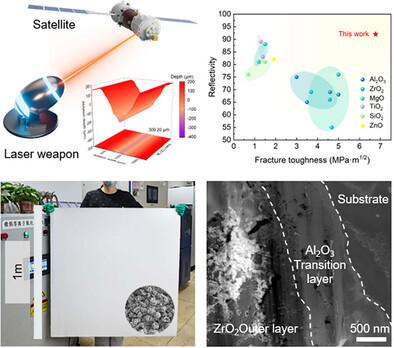Scalable Manufactured ZrO2‐Al2O3 Heterostructured Coating with High Reflectivity and Enhanced Toughness for Space Laser Protection
IF 12.1
2区 材料科学
Q1 CHEMISTRY, MULTIDISCIPLINARY
引用次数: 0
Abstract
Developing ceramic coatings with high reflectivity, emissivity, and mechanical robustness is critical for enhancing laser protection and thermal management in various optical precision instruments and engineering equipment. However, insufficient optical and mechanical performance causes heat accumulation and fracture under thermomechanical stress that can lead to catastrophic failure. Herein, a scalable ZrO

具有高反射率和增强韧性的可扩展制造ZrO2 - Al2O3异质结构涂层用于空间激光防护
开发具有高反射率、高发射率和高机械稳健性的陶瓷涂层对于提高各种光学精密仪器和工程设备的激光防护和热管理至关重要。然而,不充分的光学和机械性能会导致热积聚和热机械应力下的断裂,从而导致灾难性失效。本文通过一种简单而有效的策略制备了具有抗激光烧蚀、热管理和韧性的可扩展ZrO2 - Al2O3异质结构涂层。涂层表面微凸结构的多次散射和非均质界面处的折射率失配使其反射率提高到92% (780 ~ 2500 nm),有效辐射面积的扩大使其发射率提高到0.93(8 ~ 25µm)。高反射率和0.6 W/(m K)的低导热系数使涂层能够达到637 W cm−2的激光损伤阈值,持续时间为35 s,与单一Al2O3涂层相比,损伤深度降低了35.46%。值得注意的是,由于氧化锆相变增韧和非均相界面能吸收的协同作用,涂层的断裂韧性达到6.77 MPa m1/2。这些特性使ZrO2‐Al2O3异质结构涂层成为各种激光防护和热管理应用的潜在保护材料。
本文章由计算机程序翻译,如有差异,请以英文原文为准。
求助全文
约1分钟内获得全文
求助全文
来源期刊

Small
工程技术-材料科学:综合
CiteScore
17.70
自引率
3.80%
发文量
1830
审稿时长
2.1 months
期刊介绍:
Small serves as an exceptional platform for both experimental and theoretical studies in fundamental and applied interdisciplinary research at the nano- and microscale. The journal offers a compelling mix of peer-reviewed Research Articles, Reviews, Perspectives, and Comments.
With a remarkable 2022 Journal Impact Factor of 13.3 (Journal Citation Reports from Clarivate Analytics, 2023), Small remains among the top multidisciplinary journals, covering a wide range of topics at the interface of materials science, chemistry, physics, engineering, medicine, and biology.
Small's readership includes biochemists, biologists, biomedical scientists, chemists, engineers, information technologists, materials scientists, physicists, and theoreticians alike.
 求助内容:
求助内容: 应助结果提醒方式:
应助结果提醒方式:


